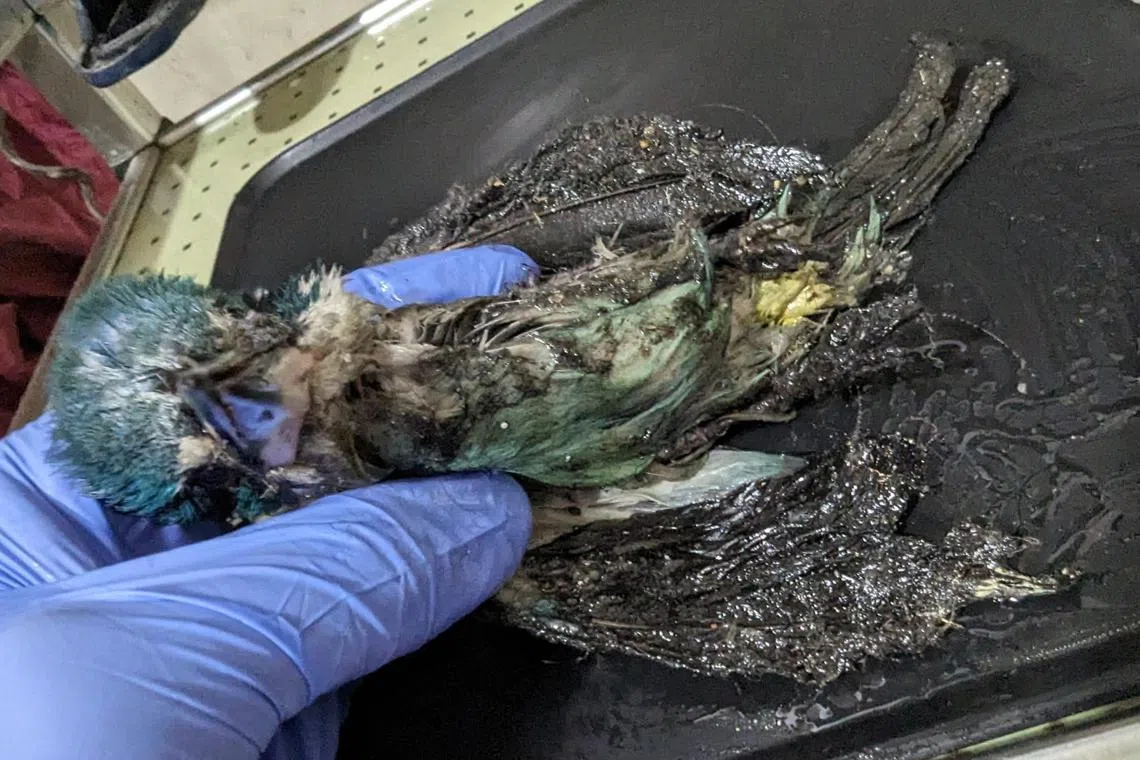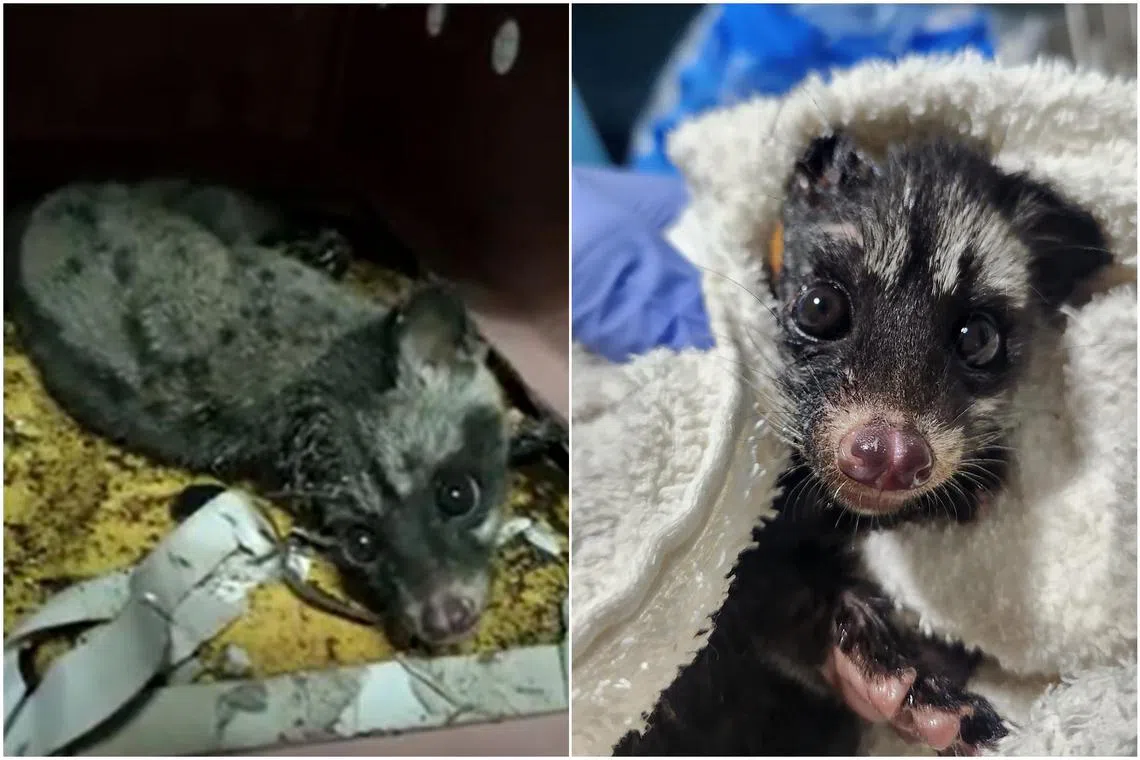Glue traps for pests can’t be used in outdoor areas where wildlife can get caught
Sign up now: Get ST's newsletters delivered to your inbox

A collared kingfisher caught on a glue trap.
PHOTO: ACRES
Follow topic:
SINGAPORE – Pest control firms deploying glue traps cannot use them in outdoor or semi-open areas, have to ensure they are checked daily, and limit their size, according to new guidelines issued by the authorities.
This is to prevent the traps – commonly used to get rid of rats, lizards and other pests – from ensnaring wildlife.
These revised guidelines – seen by The Straits Times – were outlined in a circular the National Parks Board (NParks) and the National Environment Agency (NEA) sent to pest control operators on May 15.
Glue traps must not be used adjacent to each other, or in outdoor or semi-open areas unless there are strong reasons to do so, such as the need to control serious rat infestations. These reasons must also be documented by pest control companies after they assess the affected site to clearly justify why glue traps are needed.
Other recommendations include limiting the size of the glue traps to a maximum of 35cm by 25cm, and removing caught rats and rescuing trapped wildlife within three hours of finding the trapped animals.
These revised recommendations were made by NParks, NEA and the Singapore Pest Management Association.
Pest control companies or staff that do not follow the guidelines may be taken to task for animal cruelty, the circular stated.
Trapped rats and pests must be killed humanely and disposed of properly by double bagging the remains and sealing the bags securely, the document added. After each pest control case is handled, the glue boards must be disposed of.
Trapped wildlife must be released from the trap unharmed and have the glue removed. Pest control firms can send affected domestic animals to the vet or call NParks’ Animal Response Centre. For wildlife such as snakes and birds, they should be handed over to NParks’ Animal and Plant Health Centre.
This is the first update on glue trap guidelines since they were issued in 2012.
Between 2014 and 2023, the Animal Concerns Research and Education Society (Acres) rescued nearly 2,000 trapped wild animals, it said in early May in a survey it conducted to raise awareness about the ill effects of glue traps.
A quarter of the animals rescued were protected species such as kingfishers, bats and civets. A baby common palm civet was trapped at an army camp and a kitten at a wet market in Tampines.

Acres rescued this baby common palm civet after it was found plastered to a glue trap at an army camp in late January 2023.
PHOTOS: ACRES
Animals caught in glue traps tend to suffer from starvation, dehydration and suffocation. Even those rescued face a gruelling recovery process.
Acres’ view is that traps will not solve the root problem of pest infestation. The availability of food scraps, water and shelter allows pests to thrive, which means that managing waste and preventing littering is key, said the organisation’s co-chief executive, Ms Anbarasi Boopal.
Acknowledging the updated guidelines as a positive step, Ms Anbarasi said: “Site assessment must be conducted and documented clearly to justify the need for deploying glue traps, and that will serve as a measure of check. Another positive outcome is that glue traps must be checked daily.”
She hopes these guidelines will be made mandatory and that the sale and use of such devices among the public will be restricted.
Currently, there is no regulation of the sale and use of glue traps by members of the public. Glue boards and cans of anti-pest glue are sold online and in hardware stores.
In the Acres survey, only 26 per cent of 1,000 respondents hired pest control firms when faced with rat infestations.
The survey also found that fewer than one in five people here is aware of the ill effects of glue traps.
Mr Mohamad Hamzah, a manager at pest control firm AZantz Services, suggested that educational campaigns and information on the proper use of glue traps can be put up at shops and public spaces.
He said the release of updated guidelines is a positive step towards humane pest control methods to reduce unnecessary suffering to animals.
“It may add a slight burden on pest control operators in adhering to the new guidelines, but these measures are needed to ensure animal welfare standards are upheld,” he added.
The company’s main practice to tackle rodents is to use rodenticide and chemicals at their burrows in the surrounding areas and seal any areas that are possible shelter for rats.
“We work together with stakeholders to ensure waste and rodent food sources are eliminated,” Mr Hamzah said.
Mr How Choon Beng, NParks’ group director of wildlife management, said the board “will continue to work with the relevant stakeholders to prevent non-target animals from being trapped and ensure that appropriate measures are taken to respond to trapped animals”.
“In addition, NParks provides wildlife management training courses... (and) works closely with the animal management industry to create greater capacity and professionalism,” he added.
Countries such as Ireland, New Zealand and Norway have banned glue traps over animal welfare concerns. Other methods include the use of rat cages, rodenticide, chemicals and spring traps.
In a written response to a parliamentary question on this issue on May 8, Minister for Sustainability and the Environment Grace Fu said glue traps are an effective tool for trapping and removing rats when used responsibly and safely.


